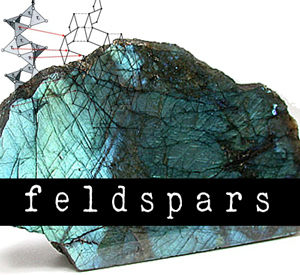

Amazonite takes its name from the Amazon river, though ironically, no actual amazonite deposits are found along the river. (Deposits of high quality amazonite are found elsewhere in Brazil.) It is a blue-green variety of microcline, a common potassium feldspar found in granite pegmatites and metamorphic rocks. The Ilmen mountains in Russia were the primary source for amazonite, but deposits have been found in the US, Australia and Madagascar as well as Brazil.
The stones grouped here are generally granular feldspars with mottled appearance and colors from lighter beige and grays to pink. Epidote is a dark green silicate mineral forming with feldspars. Feldspars may be potassium-rich alkali feldspars or calcium-rich plagioclase feldspars.
The schiller effect in labradorite is pronounced, showing lovely blue-green iridescence from the cleavage surfaces. As labradorite cools, two planes develop from internal chemical separation and it's the light scattering from these planes that create the iridescence. Labradorite is a middle range feldspar, between potassium feldspars on one end and sodium / calcium feldspars on the other. The base color is generally blue-gray or dark-gray but it can also be colorless or white. Most labradorite comes from Canada, Madagascar, Finland and Russia.
Moonstone gemstones are typically potassium-bearing feldspar (orthoclase), but they can be sodium-bearing feldspar (anorthoclase, sanidine, albite). The potassium-rich moonstone tends to show more variety in color (cream, grey, peach) with a soft, infused glow of color that results from internal reflections off inclusions. In contrast, plagioclase feldspars like labradorite show brighter flashes of color from reflections off crystalline structure.
Prehnite is a phyllosilicate (organized in sheets) named for the Dutch officier Hendrik von Prehn, its discoverer in the late 1700s. Its found lining volcanic cavities and associated with calcite and mineral veins in granite. Gemstone quality stones tend to be pale green, but it can also be yellow or gray. It's generally not found in prismatic form; mostly it appears as short crystals in globular clusters. Sources include Canada, Australia, Scotland and Germany.
Despite its name, rainbow moonstone is more similar to labradorite, a plagioclase feldspar, than an orthoclase feldspar like moonstone or an oligoclase feldspar such as sunstone. Like labradorite, rainbow moonstone shows the pleasing flash of color - andularescence - resulting from light reflecting from thin parallel planes rather than the glowing infused light from albite inclusions in moonstone proper. Rainbow moonstone originated from Madagascar, though deposits are found worldwide.
Sunstone is an oligoclase (sodium-rich) feldspar with a rich reddish glow from hematite inclusions. "Oregon sunstone" is included here, but it is actually labradorite found in Oregon. Sunstone may also be bytownite, a rare sodium / calcium feldspar found in Canada, that is more yellow-orange in appearance.
Tanzanite is a blue-purple variety of zoisite found almost exclusively on Tanzania. Vanadium gives the stone its blue color, and tanzanite crystals show pleochroism (different colors when viewed from different angles). The most valuable tanzanite is deep violet in color without inclusions, though specimens of this sort are rare. Tanzanite is often heat-treated to enhance its color and remove any brownish tints, and this effect is permanent.
Vesuvianite is a green or chartreuse colored stone that forms in metamorphic regions of limestone. It's found in marble and frequently accompanied with diopside, grossular garnet and calcite. It's named for Mt. Vesuvius where it was first discovered.
When used in jewelry, zoisite is more often ruby in zoisite, which is a green stone with opaque ruby and black hornblende inclusions. Zoisite that is more pink than green is called thulite, and this should not be confused with ruby fuchsite, which is opaque ruby ringed with blue kyanite within fuchsite (mica group) which is more blue-green in color. Ruby in zoisite comes from Tanzania, where it was found. It forms in metamorphic regions, such as hydrothermal alteration of igneous rocks, but it can also be found in pegmatites and quartz veins.